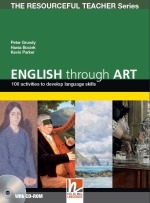English Through Art
reviewed by Alan Maley, UK

English Through Art: 100 activities to develop language skills.
Peter Grundy, Hania Bociek, Kevin Parker
2011
Helbling Languages
The rich resource of visuals as a stimulus for language teaching practice has been explored periodically in recent years. The earlier work of Maley et al (1980) on visual images has been extended more recently by Goldstein (2008) and Keddie (2009) Tomalin and Stempleski’s 2001 work on the moving image is a continuing source of inspiration. Andrew Wright’s How to Enjoy Paintings (1987) and Pictures for Language Learning (1989) have offered us insights into the specific ways art achieves its effects, as well as suggesting ways of exploiting it as a language learning resource. This book is therefore a most welcome addition to the growing current of appreciation of the role art can play in language learning. Furthermore, it forms part of the rising tide of interest in the whole range of aesthetic approaches to language education, including not only art but also music, song, theatre clowning, creative writing and drama, which have been the subject of recent attention.. (Lutzker 2007, Maley 2009/10)
The book offers 100 activities in a standard format for language learners ranging from elementary to advanced levels. The activities draw heavily on 50 art pictures of various kinds which are printed in full colour at the end of the book and are also available on the accompanying CD-ROM. There are eight chapters grouping activities into roughly similar categories: What’s in a Painting? Look Again At; Being Imaginative; Being Creative; Making Decisions; Ourselves; Vocabulary Building; Writing. The standard format for all activities comprises: Level, Time, Materials, Suggested Images, Language Focus, Indicative language, Aims and preparation – followed by step by step instructions for what to do In Class., and occasionally, additional Comments, Variations or Follow up.
The Introduction claims that ‘our ‘visual literacy’ is just waiting to be turned into spoken and written language.’ (p7) It makes a case for using art: its memorability, its potential to stir creativity, its harnessing of careful noticing and observation, and its educational value over and above any language learning pay-off. It also deals with some of the more thorny issues such as the accessibility of art to young students, and the kinds of objections commonly raised.
Many of the activities themselves will be familiar to teachers (2.16 Spot the Difference; 2.17 20 Questions; 3.2 Family Trees; 4.7 The Mystery Object, etc.). The originality lies in their link with art. Quite a number of activities seem overly complex, with complicated instructions which a teacher would find it difficult and time-consuming to interpret. (1.13 Emotion-Feelings; 2.4, Comparison: Through the Years; 2.15 Question and Answer; Time Traveller, etc.) And one or two, like 3.5 Behind Closed Doors, have only the most tenuous connection with art. However, there are plenty of more original activities to attract the teacher with a feel for creativity.( 3.8 Soundscapes; 4.5 Making an Art Gallery; 6.8 Landscapes, etc.) However, I felt it was a pity not to have pursued some more art-focussed lines: how to become picture literate, the lives and thoughts of artists themselves, the linking of art with other media. This would have been in keeping with the book’s intention to educate as well as to instruct. (p137)
The pictures themselves I found disappointing. They are predominantly traditional, representational art with no contemporary work represented. They are all western art, which raises questions of cultural appropriacy. In the book reproductions, they are a touch muddy-looking and unlikely to be attractive, especially to a young audience, though in the CD-ROM they are crisp, clear and more striking. I know how expensive it is to obtain copyright in pictures, so it is perhaps inevitable that the authors used what they could find. What would have been welcome, however, would have been a more clearly-signposted section on other visual resources on the web. This could have been combined with a section of references to other books and materials available. (Abse, 1986; Benton, 1990, Berger, 1972, Gombrich, 1966; Gregory, 1977, etc.)
Would I buy this book? Yes. Would I use it? Selectively. Would I recommend it to other teachers? Only if they were prepared to invest the time and energy required in making it work for them.
References
Abse, Dannie and Joan. 1986. Voices in the Gallery. London: The Tate Gallery.
Benton, Michael and Peter.1990. Double Vision. London: Hodder and Stoughton.
Berger, John. 1972. Ways of Seeing. London: Penguin.
Goldstein, Ben. 2008. Working with Images. Cambridge: Cambridge University Press.
Gombrich, E.H. 1966. The Story of Art. London: Phaidon.
Gregory, R.L. 1977. Eye and Brain: The psychology of seeing. London: Weidenfeld and Nicolson.
Keddie, Jamie 2009. Images. Oxford: Oxford University Press.
Lutzker, Peter. 2007. The Art of Foreign Language Teaching. Tubingen und Basel: Francke Verlag
Maley, Alan. 2009/10 Towards and Aesthetics of ELT. Folio. Vol. 13.2, 2009 and 14.1, 2010.
Maley, Alan, Alan Duff, Francoise Grellet. 1980. The Mind’s Eye. Cambridge: Cambridge University Press.
Tomalin, Barry and Susan Stempleski. 2001. Film. Oxford: Oxford University Press.
Wright, Andrew 1987. How to Enjoy Paintings. Cambridge: Cambridge University Press.
Wright, Andrew 1989. Pictures for Language Learning. Cambridge: Cambridge University Press.

Please check the CLIL: Content and Methodology for Primary Teachers course at Pilgrims website.
Please check the CLIL: Content and Methodology for Secondary Teachers course at Pilgrims website.
Please check the Creative Methodology for the Classroom course at Pilgrims website.


|